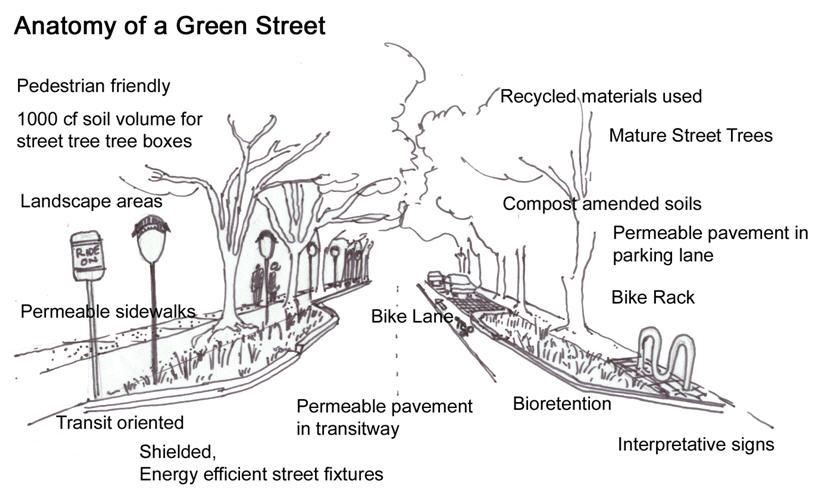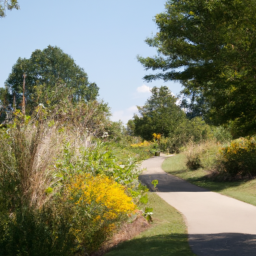In this article, you will learn about the concept of green streets and how they can enhance water quality and neighborhood aesthetics. Green streets are a stormwater management approach that uses vegetation, soil, and engineered systems to slow, filter, and cleanse stormwater runoff from paved surfaces. Unlike traditional streets that direct stormwater into the sewer system, green streets capture rainwater at its source, protecting water quality and replenishing groundwater supplies. By implementing green streets, you can also reap benefits such as carbon absorption, improved air quality, and a more visually pleasing neighborhood.
The advantages of green streets go beyond aesthetics. They can reduce peak stormwater flows, eliminating the need for costly underground systems and minimizing energy costs for the community. Additionally, green streets help to minimize stormwater impacts, increase the infiltration and filtration of runoff, and mitigate flooding. Not to mention, they also improve pedestrian and bicycle access, making your neighborhood more walkable and bike-friendly. Street trees incorporated into Green Street strategies can help reduce the Urban heat island effect. For those interested in incorporating green streets into their community, there are various resources available, such as guides and handbooks from organizations like WERF and the City of Portland, that can assist you in the design and use of green streets.
Green Streets for Enhancing Water Quality and Neighborhood Aesthetics
A green street is a stormwater management approach that incorporates vegetation, soil, and engineered systems to slow, filter, and cleanse stormwater runoff from impervious surfaces. Unlike traditional streets that direct stormwater runoff into storm sewer systems that discharge into surface waters, green streets capture rainwater at its source. This innovative approach offers numerous benefits, including water quality protection, groundwater replenishment, carbon absorption, air quality improvement, and enhanced neighborhood aesthetics.

What is a Green Street?
Definition
A green street is a stormwater management technique that integrates natural elements, such as vegetation and soil, with engineered systems to reduce the impact of stormwater runoff on the environment. By mimicking natural hydrologic processes, green streets help to slow the flow of stormwater, filter pollutants, and promote groundwater recharge.
Components
Green streets typically consist of several components working together to manage stormwater effectively. These components include permeable pavement, bioretention areas, rain gardens, bioswales, and tree trenches. These features are strategically designed to capture, infiltrate, and treat stormwater before it reaches nearby bodies of water.
Benefits
Green streets offer a wide range of benefits to both the environment and the community. Some of the key benefits include:
-
Water Quality Protection: Green streets help to filter out pollutants from stormwater runoff, preventing them from entering rivers, lakes, and streams. The vegetation and soil act as natural filters, removing harmful substances and sediment.
-
Groundwater Replenishment: By allowing stormwater to infiltrate into the ground, green streets promote groundwater recharge. This helps to replenish local aquifers, ensuring a sustainable water supply.
-
Carbon Absorption: The vegetation in green streets plays a vital role in absorbing carbon dioxide, a greenhouse gas that contributes to climate change. By sequestering carbon, green streets help mitigate the effects of climate change.
-
Air Quality Improvement: Green streets with abundant vegetation can improve air quality by capturing and filtering pollutants, such as particulate matter and nitrogen dioxide. The trees and plants also produce oxygen, helping to create a healthier environment.
-
Enhanced Neighborhood Aesthetics: Green streets improve the overall appearance of neighborhoods by introducing green spaces and enhancing the natural beauty of the area. The presence of vegetation and natural elements can increase property values and promote community well-being.
How do Green Streets work?
Rainwater Capture
Green streets are designed to capture rainwater at its source. Instead of allowing rainwater to flow directly into storm sewers, green streets redirect the runoff to permeable surfaces, such as permeable pavement or bioswales. These surfaces allow rainfall to infiltrate into the ground slowly, reducing the volume and velocity of stormwater entering the drainage system.
Stormwater Management
Green streets employ various techniques to effectively manage stormwater. Bioretention areas, rain gardens, and bioswales are designed to collect stormwater and allow it to slowly percolate through layers of vegetation and soil. This process helps to remove pollutants and sediment, improving the quality of the water before it is discharged into the environment.
Environmental Impact
By incorporating natural elements into urban environments, green streets mitigate the negative environmental impacts of conventional stormwater management systems. Traditional storm sewers quickly transport stormwater runoff, often carrying pollutants and sediment directly into surface waters. Green street infrastructure, on the other hand, mimics natural hydrologic processes by allowing stormwater to infiltrate into the ground, where it can be naturally filtered and treated.

Advantages of Green Street Infrastructure
Water Quality Protection
One of the most significant advantages of green streets is their ability to protect water quality. By filtering pollutants and sediment, green streets help to prevent contamination of nearby rivers, lakes, and streams. This not only benefits the local ecosystem but also helps to ensure a safe and sustainable water supply for communities.
Groundwater Replenishment
Green streets play a vital role in replenishing groundwater supplies. By allowing stormwater to infiltrate into the ground, green streets promote groundwater recharge. This helps to maintain healthy water levels in aquifers, which are essential for drinking water and agricultural irrigation.
Carbon Absorption
Green streets contribute to carbon sequestration by absorbing carbon dioxide from the atmosphere. Trees and plants in green streets capture carbon dioxide during photosynthesis and store it in their biomass. This helps to mitigate climate change by reducing the concentration of greenhouse gases in the atmosphere.
Air Quality Improvement
Another advantage of green streets is their positive impact on air quality. Vegetation and natural elements in green streets help to capture and filter pollutants, such as particulate matter and nitrogen dioxide. By removing these harmful substances from the air, green streets create a healthier environment for residents and improve overall air quality in surrounding areas.
Enhanced Neighborhood Aesthetics
Green streets go beyond their functional benefits and add aesthetic value to communities. By introducing green spaces and incorporating natural elements into urban environments, green streets enhance the beauty of neighborhoods. The presence of vegetation, trees, and other landscaping elements creates a more inviting and pleasant atmosphere, improving the overall quality of life for residents.
Cost Savings and Efficiency
Peak Stormwater Flow Reduction
Green streets can significantly reduce peak stormwater flows, thereby reducing the risk of flooding. By slowing down the flow of stormwater and allowing it to infiltrate into the ground slowly, green streets help to mitigate the impact of heavy rainfall events. This reduces the strain on existing stormwater infrastructure and minimizes the risk of overloading the system during peak flow periods.
Elimination of Expensive Underground Systems
Traditional stormwater management systems often rely on expensive underground infrastructure, such as large pipes and storage facilities. In contrast, green streets can significantly reduce the need for such systems. By naturally infiltrating and treating stormwater on-site, green streets eliminate the need for extensive underground infrastructure, resulting in cost savings for communities.
Minimized Energy Costs
Green streets can also help to reduce energy costs associated with stormwater management. Traditional storm sewers require energy-intensive pumps to transport stormwater runoff. In contrast, green streets allow stormwater to be naturally absorbed and infiltrated into the ground, minimizing the need for energy consumption. This results in reduced operational costs and increased energy efficiency for communities.

Stormwater Impacts
Infiltration and Filtration of Runoff
Green streets facilitate the infiltration and filtration of stormwater runoff. By capturing rainwater at its source and directing it to permeable surfaces, green streets enable the slow percolation of stormwater through layers of vegetation and soil. This process helps to filter out pollutants and sediment, improving the quality of the water before it reaches nearby bodies of water.
Flow Reduction
Green streets play a crucial role in reducing the volume and velocity of stormwater runoff. By slowing down the flow of stormwater, green streets help to prevent erosion and minimize the risk of flooding. By managing the flow of stormwater, green streets can protect the stability of stream banks, prevent property damage, and enhance overall water management.
Flood Mitigation
Green streets contribute to flood mitigation by reducing the volume and velocity of stormwater runoff. By capturing and infiltrating rainwater on-site, green streets help to prevent excess water from overwhelming the drainage system and causing localized flooding. This can provide peace of mind to residents and reduce the financial burden of flood damage.
Pedestrian and Bicycle Access Improvement
Green streets can also enhance pedestrian and bicycle access in urban areas. By incorporating landscaping features, such as trees, plantings, and pathways, green streets create more inviting and user-friendly environments for pedestrians and cyclists. This encourages active transportation and promotes healthier, more sustainable modes of travel.
Resources for Green Street Design and Use
Checkout more info from EPA
WERF Guides
The Water Environment Research Foundation (WERF) provides guides and resources for green street design and implementation. These guides offer valuable information on best practices, case studies, and technical guidance for designing effective green street projects. They can be a helpful resource for engineers, landscape architects, and urban planners involved in green street design.
City of Portland Handbooks
The City of Portland has developed handbooks and manuals specifically focused on green street design and implementation. These resources provide guidance on the design, construction, and maintenance of green streets in urban areas. They offer practical solutions and examples from one of the leading cities in green infrastructure development.
Conclusion
Green streets offer a sustainable and environmentally friendly approach to stormwater management. By integrating natural elements with engineered systems, green streets provide numerous benefits, including water quality protection, groundwater replenishment, carbon absorption, air quality improvement, and enhanced neighborhood aesthetics. They also offer cost savings and efficiency by reducing peak stormwater flows, eliminating the need for expensive underground systems, and minimizing energy costs. With their ability to mitigate stormwater impacts, green streets can help to create healthier communities with improved water quality and enhanced accessibility. Resources, such as guides and handbooks, are available to assist in the design and implementation of green street projects, making it easier for communities to adopt this innovative stormwater management approach. By embracing green streets, communities can enhance both the environment and the quality of life for residents.

